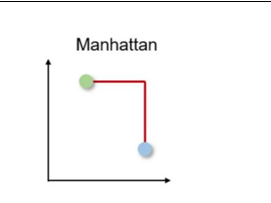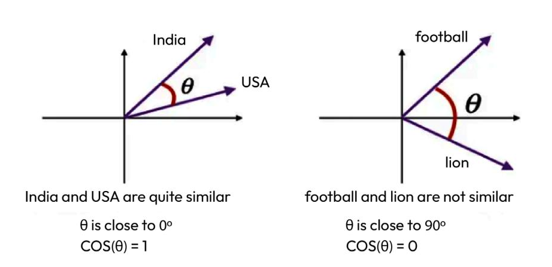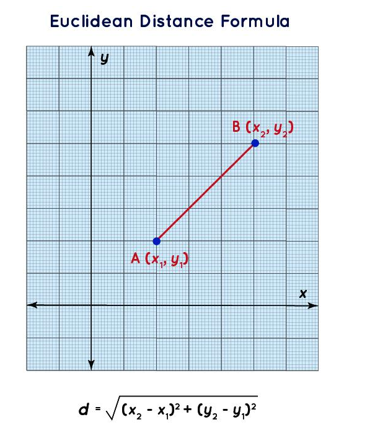The image illustrates the Euclidean distance formula in a 2D space. It shows two points: (x1,y1) and (x2,y2). The preceding formula calculates the straight-line distance between the two points in a plane.
- Distance metrics – Manhattan (L1): Manhattan distance calculates the sum of absolute differences along each dimension. The higher the metric, the less similar the differences. The following image depicts the Manhattan distance (or L1 distance) between two points in a 2D space, where the distance is measured along the axes at right angles, similar to navigating city blocks in a grid-like street layout:

Figure 4.8 – Illustration of Manhattan distance
You might be wondering when to select one metric over another during the development of generative AI applications. The decision on which similarity measure to use hinges on various elements, such as the type of data, the context of the application, and the bespoke demands of the analysis results.
Cosine similarity is preferred over Manhattan and Euclidean distances when the magnitude of the data vectors is less relevant than the direction or orientation of the data. In text analysis, for example, two documents might be represented by highly dimensional vectors of word frequencies. If one document is a longer version of the other, their word frequency vectors will point in the same direction, but the magnitude (length) of one vector will be larger due to the higher word count. Using Euclidean or Manhattan distance would highlight these differences in magnitude, suggesting the documents are different. However, using cosine similarity would capture their similarity in content (the direction of the vectors), de -emphasizing the differences in word count. In this context, cosine similarity is more appropriate, as it focuses on the angle between the vectors, reflecting the content overlap of the documents rather than their length or magnitude.
Euclidean and Manhattan distances are more apt than cosine similarity when the magnitude and absolute differences between data vectors are crucial, such as with consistent scaled numerical data (e.g., age, height, weight, and so on) or in spatial applications such as grid-based pathfinding. While cosine similarity emphasizes the orientation or pattern of data vectors, which is especially useful in highly dimensional, sparse datasets, Euclidean and Manhattan distances capture the actual differences between data points, making them preferable in scenarios where absolute value deviations are significant such as when comparing the medical test results of patients or finding the distance between geographical co-ordinates on earth.
The following is a snippet of code that uses Azure OpenAI endpoints to calculate the similarity between two sentences: “What number of countries do you know?” and “How many countries are you familiar with?” by using embedding model text-embedding-ada-002. It gives a score of 0.95:
import os
import openai
openai.api_type = “azure”
openai.api_base = “https://ak-deployment-3.openai.azure.com/”
openai.api_version = “2023-07-01-preview”
##replace “2023-07-01-preview” with latest version openai.api_key = “xxxxxxxxxxxxxxxxxxxxxxx”
def get_embedding(text, model=”text-embedding-ada-002″):
return openai.Embedding.create(engine=model, input=[text], \ model=model)[‘data’][0][’embedding’]
embedding1 = get_embedding(“What number of countries do you know?”, \
model=’text-embedding-ada-002′)
embedding2 = get_embedding(“How many countries are you familiar \
with?”, model=’text-embedding-ada-002′)
embedding1_np = np.array(embedding1)
embedding2_np = np.array(embedding2)
similarity = cosine_similarity([embedding1_np], [embedding2_np])
print(similarity)
# [[0.95523639]]
Now let us walkthrough a scenario where Cosine Similarity will be preferred over Manhattan distance.

